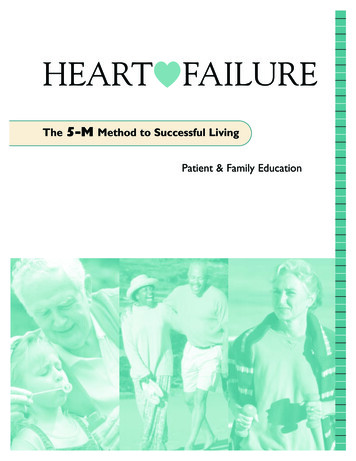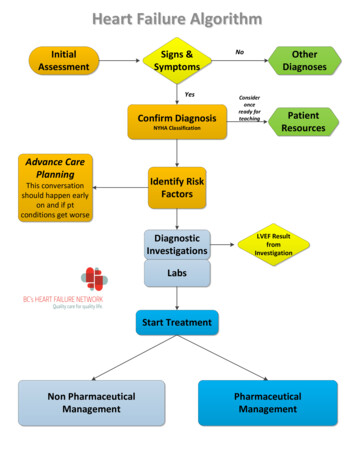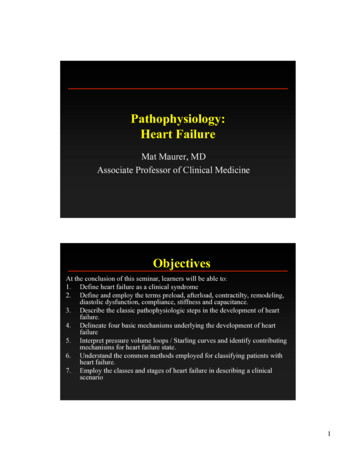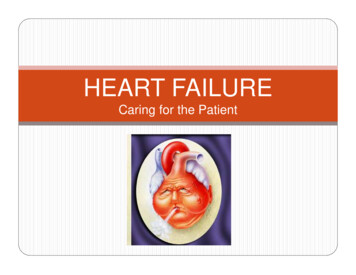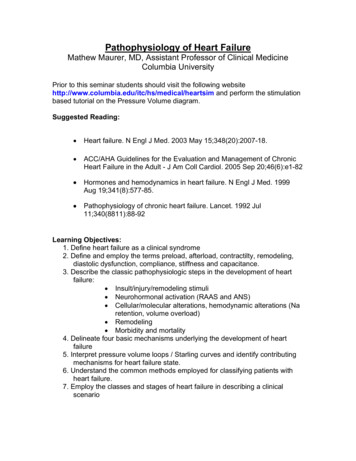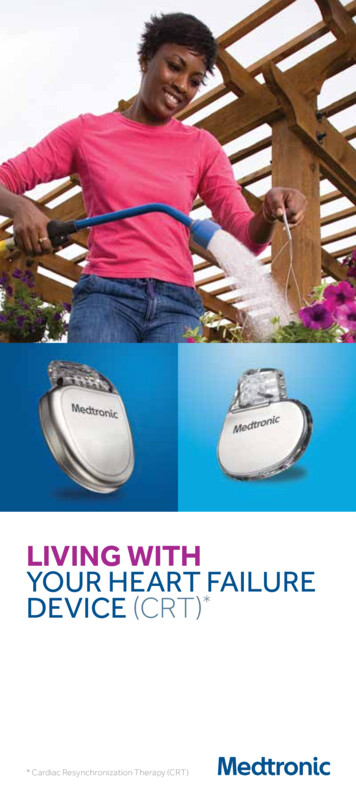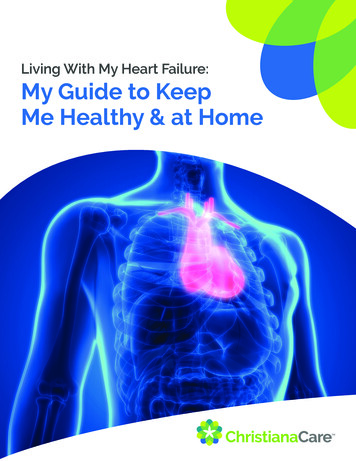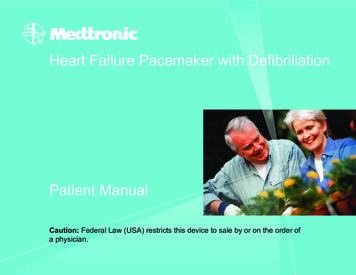
Transcription
Heart Failure Pacemaker with DefibrillationPatient ManualCaution: Federal Law (USA) restricts this device to sale by or on the order ofa physician.
Innovating for life.The following list includes trademarks or registered trademarks of Medtronic in theUnited States and possibly in other countries: CareLink, Medtronic, MedtronicCareAlert, Medtronic CareLink, MLink. All other trademarks are the property of theirrespective owners. Medtronic, Inc. 2012M947701A001B2012-06-29
How to contact MedtronicContact us by phoneOur experienced Patient Services group is available to answer anyquestions or concerns you may have about your heart device. To speakdirectly with a Patient Services Specialist, call 1-800-551-5544. Our staffis available Monday through Friday from 8:00 AM to 5:00 PM (CentralTime).Contact us onlineMedtronic is dedicated to providing you with the most up-to-dateinformation available about your Medtronic heart device. Websiteinformation is available 24 hours a day. Medtronic website: www.medtronic.com Patient Services website: www.medtronic.com/rhythmsIf you would like to submit questions, suggestions, or requests to usonline, you can use the online form provided at www.medtronic.com/corporate/contact.jsp.3
Contact us by mail or faxMedtronic, Inc.Patient Services DepartmentMail Stop MVS 148200 Coral Sea Street NEMounds View, MN 55112Fax: 763-367-5809Contacting Medtronic about your ID CardTo update information on your ID card or if you have questions aboutyour ID card, see “Your heart device ID card” on page 97.4
Information about you and your deviceYour personal informationYour nameYour doctor’s name SpecialtyYour doctor’s name SpecialtyDoctors’ phoneYour medicationsEmergency contact informationName/address PhoneName/address PhoneYour heart device informationType of heart deviceLead 1 model numberLead 2 model numberLead 3 model numberDate of implantSerial #Serial #Serial #Serial #Hospital where implanted5
6
ContentsHow to contact Medtronic3Information about you and your device5Chapter 1Why read this manual? 13Frequently asked questions 14Chapter 2Living life with your heart device 25Food and medications 26Recommendations about your physical activity 26Recreation and activities 27Driving a car 27What you need to know about electromagneticcompatibility (EMC) 28General guidelines for avoiding interference fromelectrical items or magnets 327
Examples of items that have low or no risk of interferingwith your device 42Precautions about medical procedures 44Medical procedures that are not recommended 45Medical procedures that require some precautions 46Acceptable medical procedures 48Chapter 3Your heart has a natural rhythm 51The anatomy of the heart 51Electrical conduction in the heart 55How abnormal heart rhythms affect the heart 58Heart failure – When the heart pumps poorly 59Tachyarrhythmia – When the heart beats too fast 64Bradycardia – When the heart beats too slowly 67Chapter 4About your heart device 69What is a heart failure pacemaker with defibrillation?Your heart device 70Implanted leads 71What does my heart device do? 74870
What types of therapies does my heart device provide? 74Therapy for an uncoordinated and irregular heartrhythm 75Therapies for a fast heart rhythm 78Therapy for a slow heart rhythm 80What do the therapies feel like? 81What is Medtronic CareAlert monitoring? 82Conditions that Medtronic CareAlert monitoring candetect 84Checking your Medtronic CareAlert status 85Chapter 5Your implant procedure and recovery 87The implant procedure 88Making the incision and inserting the leads 88Testing the leads 89Implanting the heart device and closing the incisionPotential risks after the implant procedure 90Recovering after your implant surgery 92Follow-up appointments 93899
Chapter 6Registering your heart device 95Heart device registration form 96Your heart device ID card 97Carry your heart device ID card with you at all times 97To request a new heart device ID card or update yourpersonal information 98If you change your doctor 98Medtronic heart device travel card 98Chapter 7Follow-up care 101Follow-up information 102Remote monitoring with the Medtronic CareLinkService 103Medtronic CareLink Programmer 107Reviewing information saved by your heart deviceWhen to call your doctor or nurse 109Heart device replacement 110Chapter 810Caring for yourself 111Dealing with anxiety and getting the support you need108112
Medical care 115Planning for an emergency 116What your family and friends should knowMedtronic WarrantyGlossaryIndex11711912113711
12
1Why read this manual?Your doctor or doctors should be your first source of information aboutyour heart condition and your general health.If you have questions about your heart device that are not covered inthis manual, contact Medtronic Patient Services (see “How to contactMedtronic” on page 3).For Spanish translations of patient manuals, contact Medtronic PatientServices, or go to www.medtronic.com to view or download English andSpanish patient manuals.This manual is for people who are about to have or already have a heartfailure pacemaker with defibrillation (also called cardiacresynchronization therapy with defibrillation, heart failure heart device,biventricular heart device, and three-lead heart device). This manualexplains what the heart device is, how it is implanted, what it feels likewhen you receive therapy from the heart device, and what you can13
expect after you have your heart device. It’s a good idea to encourageyour family and caregivers to review this manual.For your convenience, words that appear in bold are defined in theglossary starting on page 121.Frequently asked questionsNew patients often have the same initial concerns about their heartdevices. Here are some of the questions new patients frequently ask.Why do I need this heart device?A heart failure pacemaker with defibrillation is designed to relieveheart failure symptoms for most patients. It improves the heart’s abilityto pump blood and oxygen to the body. Although this heart device doesnot prevent or cure your underlying heart rhythm condition, it shouldimprove your quality of life and help you get back to doing things thatyou haven’t been able to do for a while.Heart medications and surgical procedures may be prescribed insteadof, or in addition to, a heart failure pacemaker with defibrillation. Basedon your individual health condition, your doctor has determined that14Why read this manual?
the treatment provided by a heart device may help to improve yoursymptoms.Although your heart device is not a cure, it does help to protect youfrom heart rhythms that can weaken or even endanger your health.Many patients say that this heart device gives them and their families asense of security. See “Caring for yourself” on page 111 for guidance ondealing with anxiety and other concerns.Will I be able to drive?Whether you will be able to drive or not depends on your individualheart condition. The concern about driving is that you might faint if yourheart starts to beat dangerously fast. Many people with a heart failurepacemaker with defibrillation are able to resume driving if their doctorapproves and if allowed by the laws and insurance regulations in theirstate. For more information, see “Driving a car” on page 27. If you haveconcerns, talk with your doctor.Chapter 115
Will I be able to travel?Most people who have a heart device can travel without taking specialprecautions if they follow their doctor’s instructions.Wherever you travel, your heart device will monitor your heart andprovide therapy whenever it is needed. You can travel knowing thatresources for your device are available in 120 countries (see the backcover of this manual for information on contacting Medtronicheadquarters located worldwide). When you travel, your doctor mayalso be able to check your heart device remotely with the MedtronicCareLink Service (see page 103 for more information).It is unlikely that your heart device will trigger the security gates atairports or other secure buildings. If it does, present your heart deviceID card. If a handheld screening wand is used, ask the security operatornot to hold it over your heart device and not to wave the wand back andforth over your heart device. See “Security systems” on page 40 for moreinformation.A multilanguage heart device travel card is available that providesinstructions in several languages for safe security scanning; the card is16Why read this manual?
especially useful for international travel. See page 98 for moreinformation about the multilanguage heart device travel card.If you have any other travel-related questions, contact Medtronic PatientServices (see page 3) or consult the Medtronic travel website atwww.medtronic.com/traveling.Can I walk through antitheft systems found in public places?Yes, simply walk through the antitheft system at a normal pace. Undersome circumstances, the systems located in stores, libraries, and otherplaces may temporarily interfere with your heart device if you stop orlinger near this equipment. The interference stops when you move awayfrom the equipment.Can I use a mobile phone?Yes, you can use mobile phones (including cellular phones and otherwireless phones). However, mobile phones may cause electricalinterference with your heart device when the phone is turned on andheld too close to your heart device. Any effect is temporary, and simplymoving the phone away will return the heart device to its previous stateof operation.Chapter 117
To avoid any possible interference between mobile phones and yourheart device, keep all mobile phones at least 6 inches (15 centimeters)away from your heart device. When using a mobile phone, hold it to theear that is farthest away from your heart device. Also, do not carry amobile phone close to your heart device, such as in a shirt pocket (or in apants pocket if your heart device is implanted in your abdomen). Formore information about using mobile phones and other wirelesscommunication devices, see page 32.Can I use a microwave oven and other electrical items?Yes, you can use a microwave oven as well as major appliances, electricblankets, and heating pads. See “Living life with your heart device” onpage 25 for information about electrical items and any restrictions orcautions you should know about.Will my heart device need to be replaced?Yes. Because your heart device operates using a battery sealed inside theheart device, the entire heart device will need to be replaced whenbattery power falls to a low level. Battery power is affected by manyfactors, including how often your heart device provides therapy to your18Why read this manual?
heart. The battery for your type of heart device typically lasts 4 to 7 yearsafter it is implanted.The battery power is checked at each heart device follow-upappointment. Your doctor or nurse will let you know when you need tohave your heart device replaced.How often will my doctor need to check my heart device?When you go home after your implant surgery, your doctor willperiodically check your heart device. These follow-up appointments canbe performed at your clinic, or if your clinic subscribes to the MedtronicCareLink Service, you can send your heart device information directlyto your doctor or clinic from home. For more information about followup services, see “Follow-up care” on page 101.How do I know if my heart device battery is still working?The strength of your heart device battery is checked during your followup appointments, either in the clinic or through built-in devicemonitoring. Medtronic CareAlert monitoring is a safety feature builtinto your heart device that can be set up by your doctor to alert you witha beeping sound when the heart device battery power is getting low. ForChapter 119
more information about the Medtronic CareAlert monitoring feature,see “What is Medtronic CareAlert monitoring?” on page 82. Because thebattery is sealed inside your heart device and cannot be recharged, yourheart device will need to be replaced when the battery power is low. Formore information about heart device replacement, see “What isMedtronic CareAlert monitoring?” on page 82.What if my heart device is making a beeping sound?Your heart device may make a beeping sound if the Medtronic CareAlertmonitoring feature is turned on. Your doctor can have your heart devicealert you with a beeping sound under certain conditions, such as thefollowing conditions: The number of therapies you have received has increased. The battery power of your heart device is low.The beeping tone will sound for approximately 10 seconds and willrepeat periodically. Some alerts sound at the same time every day. Thealerts will continue until your heart device is checked by your doctor ornurse. Do not be alarmed by the beeping. This alert feature is designedto get your attention. If you hear beeping tones from your heart device,20Why read this manual?
call your doctor for instructions. For more information about theMedtronic CareAlert monitoring feature, see “What is MedtronicCareAlert monitoring?” on page 82.Will my device deliver a therapy shock during normal activity?This can happen, but it is unlikely. Your heart device is designed torespond to abnormal heart rates and rhythm patterns. Normal exerciseor physical activity shouldn’t trigger your heart device to deliver atherapy shock.If this ever happens, stop the activity and notify your doctor. Yourdoctor may change the settings of your heart device to prevent this fromhappening.Can others feel a therapy shock if they are touching me?Though it is very unlikely, if you receive a therapy shock, anyonetouching you may feel the shock as a muscle spasm or tingle. This can bestartling, but it will not hurt the person.Chapter 121
What if I receive a therapy shock?Ask your doctor or nurse what you should do if your heart devicedelivers a therapy shock. Your doctor or nurse should provide you withspecific instructions about when you should contact your doctor if youhave received a therapy shock.In general, follow these four steps if you feel the symptoms of a rapidheart rhythm or if you receive a therapy shock:1. Stay calm and move to where you can lie down or sit comfortably.2. Have someone stay with you until you feel better.3. If you receive more than one therapy shock or if you remainunconscious for more than 1 minute, have a companion call 911 for anambulance.If you remain unconscious and you have no pulse, a companiontrained in cardiopulmonary resuscitation (CPR) should begin CPRimmediately. When your heart starts beating again, your companionshould stop CPR.Note: Anyone touching you during a therapy shock might feel yourmuscles contract slightly; they also might see you jump with asudden start. A therapy shock will not harm a person touching you.22Why read this manual?
4. If you do not feel well after the shock, have someone call your doctorand take you to the hospital emergency room.5. Follow your doctor’s or nurse’s directions about when to call yourdoctor after receiving a shock. You may be asked the followingquestions:– What were you doing right before the shock?– What symptoms did you notice before the shock?– How did you feel right after the shock?– How are you feeling right now?Can I have sexual relations?People often have questions about resuming sexual relations afterreceiving a heart device. Most people resume sexual activity, based ontheir doctor’s guidance. You and your partner should be able to enjoy allthe benefits of intimacy.Any kind of physical activity is not likely to cause your heart device todeliver a shock. But if it does happen during intercourse, stop and notifyyour doctor just as you would if it happened during exercise. YourChapter 123
partner will not be hurt by the shock. They may feel a tingle or slightmuscle spasm, but nothing more.24Why read this manual?
2Living life with your heart deviceMany people resume their normal daily activities after full recoveryfrom surgery (see “Your implant procedure and recovery” on page 87).However, there may be certain situations that your doctor will ask youto avoid. Your doctor will provide the most important guidance for yourparticular condition.This chapter has important information about the following topics: Food and medications (see page 26). Your physical activity now that you have a heart device (see page 26). Information and instructions about any electrical equipment thatmay cause interference with your heart device (see page 28). Precautions about certain types of medical procedures (see page 44).25
Food and medicationsYour doctor may instruct you to eat or avoid eating certain foods. Forinformation about food, talk with your doctor.Your doctor may prescribe medications that will treat your heartcondition. Please talk with your doctor about medications.Recommendations about your physical activityUpon the advice of your doctor, you can gradually return to yournormal lifestyle and to activities such as these: Pursuing hobbies or recreational activitiesReturning to your jobResuming strenuous activityResuming sexual activityTravelingYour doctor might ask you to avoid situations where a few seconds ofunconsciousness could be dangerous to you or others. Such situationsmight include driving, swimming or boating alone, or climbing a ladder.26Living life with your heart device
Recreation and activitiesAvoid rough physical contact that could cause you to fall or to hit yourimplant site. Your heart device can be damaged or your leads couldbecome detached from the heart device during rough contact. If you use a rifle or shotgun, rest the butt on the shoulder of the sideopposite from your heart device. In activities that use a shoulder harness, protect your heart deviceand leads from jolts or rough rubbing. If you plan to scuba dive, discuss your medical condition with yourdoctor. General recommendations about scuba diving varydepending on many factors. Ask your doctor to contact MedtronicTechnical Services for the most up-to-date information about scubadiving recommendations.If you have additional questions about any recreational activities younormally pursue, contact Medtronic Patient Services (see page 3).Driving a carDiscuss with your doctor whether you can safely drive a car or othervehicle. You may be able to resume driving, depending on local lawsChapter 227
and insurance regulations and on your medical condition. Your doctorwill decide what is best for your safety and the safety of others.Seat belts are a very important safety device and should always be wornwhile driving or riding in a vehicle. While you are driving or riding in avehicle, the shoulder seat belt strap may feel uncomfortable during thefirst few weeks after surgery. You can place a soft towel between the seatbelt strap and your implant site to cushion the area.What you need to know about electromagneticcompatibility (EMC)Everything that uses electricity produces an electromagnetic energyfield. This energy field surrounds the electrical item while it isconnected to a source of electricity (even a battery source). The energyfield is strongest near the item and weakens with distance from the item.The relationship between these energy fields and your heart device iscalled electromagnetic compatibility (EMC). Most electromagneticenergy fields are small and weak and do not affect your heart device.Electrical items that generate strong electromagnetic energy fields maynot be compatible with your heart device.28Living life with your heart device
Because your heart device is designed to sense the electrical activity ofyour heart, it is possible that it may sense a strong electromagneticenergy field outside your body and deliver a therapy that is not neededor withhold a therapy that is needed.Several safeguards are built into your heart device to shield it fromstrong electromagnetic energy fields. For example, the metal case ofyour heart device acts as a shield against electromagnetic energy fields.There are also electronic filters built into your heart device that helpyour heart device distinguish between external electromagnetic energyfields and the internal electrical pulses of your natural heartbeat.You can avoid potential EMC problems by keeping your heart device aminimum distance away from the electrical item. See the followingpages for more information, including the recommended safe distancesfor certain types of electrical items.How could electromagnetic energy fields affect my heart device?High electromagnetic energy fields could affect how your heart devicesenses your heart rhythm. Because your heart device is designed toChapter 229
sense the electrical activity of your heart, it may also sense a strongelectromagnetic energy field outside your body.If your heart device is exposed to a strong electromagnetic energy field,it may not detect an abnormal heart rhythm or it may deliver a therapyshock when your heart does not need it. Any effects of electromagneticenergy fields on your heart device are temporary and will stop whenyou move away from the source of the electromagnetic energy field.What do I do if I think that an electrical item is affecting my heartdevice?If you feel dizzy, feel rapid or irregular heartbeats, or receive a shockwhile using an electrical item, release whatever you are touching ormove away from the item. Your heart device should immediately returnto its normal operation. If you receive a therapy shock or if yoursymptoms do not improve when you move away from the item, consultwith your doctor or contact Medtronic Patient Services (see page 3).30Living life with your heart device
What about static electricity or shocks from household outlets?Static electricity shocks will not damage your heart device.A “momentary” shock from an electrical outlet (110/220 volts) isunlikely to damage your heart device, depending on how long you stayin contact with the outlet.What items are safe and what kind of precautions do I need to take?Most electrical items are safe for you to use. However, you should keepsome items that produce a stronger electrical field a minimum distanceaway from your heart device. This minimum distance can range from 6to 12 inches (15 to 30 centimeters) or more, depending on the type ofitem. Refer to the information beginning on page 32 for recommendedsafe distances. Also, before entering an area where signs are postedprohibiting persons with an implanted heart device such as a pacemakeror defibrillator, consult with your doctor.Chapter 231
General guidelines for avoiding interference from electricalitems or magnetsThe following pages provide tips on how to avoid any possibletemporary effects of electromagnetic energy fields on your heart device.If you have questions about electromagnetic energy fields or the safe useof a specific item that is not listed in this chapter, contact MedtronicPatient Services (see page 3).Proper grounding of electrical itemsTo avoid interference from electrical current that may leak fromimproperly grounded electrical items and pass through your body,observe the following precautions: Make sure that all electrical items are properly wired and grounded. Make sure that electrical supply lines for swimming pools and hottubs are properly installed and grounded according to local andnational electrical code requirements.Wireless communication devicesWireless communication devices include transmitters that can affectheart devices. When using wireless communication devices, keep them32Living life with your heart device
at least 6 inches (15 centimeters) away from your heart device. Thefollowing items are examples of such devices: Handheld cellular, mobile, or cordless telephones (wireless phones);two-way pagers; personal digital assistants (PDAs); smartphones;and mobile email devices. Wireless-enabled devices such as laptop, notebook, or tabletcomputers; network routers; MP3 players; eReaders; gamingconsoles; televisions; DVD players; and headsets Remote keyless entry and remote car starter devicesWhat else do I need to know about using a wireless device?Heart devices have been tested with many types of wireless devicetechnologies. To ensure your heart device operates correctly when youare using a wireless device that is turned on, you can keep your heartdevice at least 6 inches (15 centimeters) away from the antenna of thedevice, such as a telephone, by holding the telephone to the ear farthestaway from your heart device. Do not carry the telephone in a pocketover the device or in a shoulder bag near the device.Chapter 233
Household and hobby itemsCaution: Household and hobby items that have motors or magnets orthat generate electromagnetic energy fields could interfere with yourheart device. You should move away from the interference source orturn off the source if you experience any dizziness or heartpalpitations.Keep your heart device at least 6 inches (15 centimeters) away from thefollowing household and hobby items: Handheld kitchen appliances, such as electric mixers Sewing machines and sergers Personal care items, such as corded handheld hair dryers, cordedelectric shavers, electric or ultrasonic toothbrushes (base charger), orback massagers Items that contain magnets, such as bingo wands, mechanic'sextractor wands (which use magnets to pick up metal items),magnetic bracelets, magnetic clasps, magnetic chair pads, or stereospeakers (even if the power for the speakers is disconnected)34Living life with your heart device
Radio-controlled toys (antenna) Two-way walkie-talkies (less than 3 watts)To avoid interference with your heart device, the following householdand hobby items require special precautions:Magnetic mattress pads or pillows– Items containing magnets caninterfere with the normal operation of your heart device if they arewithin 6 inches (15 centimeters) of the device. Avoid using magneticmattress pads or pillows because they cannot easily be kept away fromthe device.Induction cook tops– An induction cook top uses an alternatingmagnetic field to generate heat. You should keep your heart device atleast 24 inches (60 centimeters) away from the heating zone when theinduction cook top is turned on. Most glass-topped or ceramic-toppedranges use conventional heating elements beneath their flat cookingsurfaces. If you can use aluminum or glass cookware on your range andthe cooking area stays hot after the burner has been turned off, yourstove has conventional heating elements. This type of cook top will notaffect your heart device. If you need the latest information about kitchenappliances, contact Medtronic Patient Services (see page 3).Chapter 235
Electronic body fat scale–Using this type of scale is not recommendedfor heart device patients because it passes electricity through the bodyand can interfere with the device.UPS (uninterruptable power source) up to 200 amperes–Keep yourheart device at least 12 inches (30 centimeters) away from a UPS. If theUPS is operating by battery source, keep your heart device at least18 inches (45 centimeters) away.Electronic pet fences or invisible fences–Keep your heart device at least12 inches (30 centimeters) away from the buried wire and the indoorantenna of electronic pet fences or invisible fences.Home-use electric kilns–Keep your heart device at least 24 inches(60 centimeters) away from home-use electric kilns.“Beach comber” metal detectors–Keep your heart device at least24 inches (60 centimeters) away from the detector end.Boat motors–Keep your heart device at least 12 inches (30 centimeters)away from electric trolling motors or gasoline-powered boat motors.36Living life with your heart device
Portable electric generators up to 20 kilowatts–Keep your heart deviceat least 12 inches (30 centimeters) away from portable electricgenerators.Home power toolsMost home power tools should not affect heart devices; however, somehome power tools could affect heart device operation. Consider thefollowing guidelines to reduce the possibility of interference. To avoid electrical shock, keep all equipment in good working order. Be certain that plug-in tools are properly grounded or doubleinsulated. Using a ground fault interrupter (GFI) outlet is a commonsafety measure.Gasoline-powered tools and gasoline-powered yard equipment–Keepyour heart device at least 12 inches (30 centimeters) away from ignitionsystem components in tools and equipment such as lawn mowers,tractors, snowblowers, leaf blowers, chain saws, and weed eaters. Turnoff the motor before making adjustments.Chapter 237
Electric yard and handheld power tools (plug-in and cordless)–Keepyour heart device at least 6 inches (15 centimeters) away from thesetools.Car engine repair–Turn off car engines before making any adjustments.When the engine is running, keep your heart device at least 12 inches(30 centimeters) away from components of the ignition system.Soldering guns and demagnetizers–Keep your heart device at least12 inches (30 centimeters) away from these tools.Industrial equipmentAfter recovering from implant surgery, you likely will be able to returnto work, school, or daily routine. However, if you use or work near highvoltage equipment, sources of high electrical current, magnetic fields, orother electromagnetic sources that may affect device operation, consultwith your doctor or contact Medtronic Patient Services (see page 3). Youmay need to avoid using, or working near, the following types ofindustrial equipment: Electric furnaces used in the manufacturing of steel Induction heating equipment and induction furnaces, such as kilns38Living life with your heart device
Industrial magnets or large magnets, such as those used in surfacegrinding and electromagnetic cranes Dielectric heaters used in industry to heat plas
The anatomy of the heart 51 Electrical conduction in the heart 55 How abnormal heart rhythms affect the heart 58 Heart failure - When the heart pumps poorly 59 Tachyarrhythmia - When the heart beats too fast 64 Bradycardia - When the heart beats too slowly 67 Chapter 4 About your heart device 69


